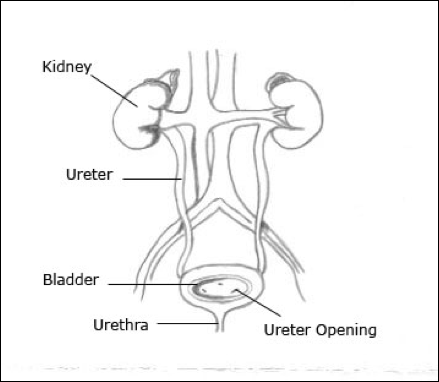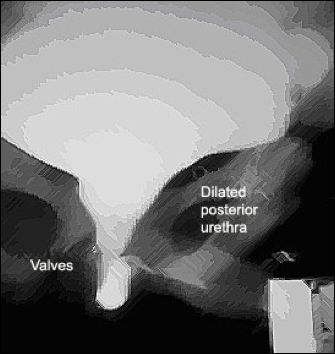Posterior urethral valves is found only in boys and occurs in about one in 8000 male babies.
It affects the urethra, which is the tube running from the bladder to the outside. The urethral valves, which are small leaflets of tissue, have a narrow, slit-like opening that partially impedes urine outflow. This makes it difficult for your son to pass urine. As the bladder muscles push harder to get the urine out, it causes pressure which may result in urine being pushed back from the bladder into the ureters and the kidneys. This causes the kidneys and bladder to swell and may lead to kidney damage.
The disorder is usually sporadic. Some genetic component is suggested because some cases can occur in twins and siblings. It happens in the early stages of pregnancy when the organs, muscle and other tissues start to form.

How does the urinary system work?
The urinary system consists of the kidneys, the bladder, ureters , urethra and testes. The kidneys filter blood to remove waste products and makes urine. The urine flows down through the ureters to the bladder.
During urination, the urine passes through a tube called the urethra to the outside of the body.
Symptoms and signs
A large proportion of boys with posterior urethral valves are detected in the first two weeks after birth and the majority in the first 6 months after birth. The symptoms and signs are;
- Painful or difficult urination.
- Weak urine stream/ dribbling.
- Delay in passing urine in the newborn.
- Frequently passing urine.
- Bedwetting or wetting pants after the child has been toilet-trained.
- Poor weight gain.
- Urinary tract infection (common at all ages).
- Swelling at the lower part of the abdomen due to enlarged urinary bladder.
Diagnosis
It can be made by an ultrasound scan in pregnancy.
- Ultrasound scan of the urinary tract [this is an imaging technique that uses high-frequency sound waves and a computer to create images of the tissues and organs like the kidney and bladder] – It shows the enlarged urinary bladder and swelling of the kidneys.
- Micturating Cystourethrogram [this is a specific X-ray that examines the urinary tract. A tube is placed in the urethra and the bladder is filled with a liquid dye. X-ray images are taken as the bladder fills and empties] – It will show the presence of PUV and whether there is any reverse flow of urine into the ureters and kidneys.
- Cystoscopy – this is a procedure that uses either a small flexible or rigid tube with a camera lens at the end to examine the inside of the bladder.
- Blood test – to evaluate kidney function.

Treatment
- Supportive care – to relieve your child’s symptoms. If your child has a urinary infection and salt imbalance, this will be treated first.He may need to have a catheter placed into the penis, through the urethra and up into the bladder to drain the urine.
- Cystoscopic ablation – A urologist (a surgeon who specializes in the disorders and care of the urinary tract) may see your child and perform a procedure called endoscopic ablation. During this procedure, an endoscope will be inserted and the valve leaflets will be incised.
- Vesicostomy – If your child’s urethra is too narrow, he may need to have a small opening made in the bladder through the abdomen. This is a temporary opening for urine to drain out while awaiting removal of the valves when your child gets bigger. It will be closed after the valves are removed.
What is the future for children with Posterior Urethral Valves?
- The outcome depends on how much damage has already occurred in the kidneys. Generally, the outcome improves when it is detected early.
- Your son will need long term follow-up with the paediatric nephrologist (paediatric doctor who is an expert in urinary tract problems) or child specialist and urologist. Even after treatment, he will need regular ultrasound scans of the urinary tract, assessment of growth, blood pressure and blood test for kidney function. Assessment of his bladder pressure and function (urodynamics) may also be needed.
- Urinary incontinence may be a long-term problem after treatment.
- Nearly 30% of boys may have terminal or end-stage kidney failure, hence the need for long-term monitoring and follow-up .
References :
- Nelson’s Textbook of Pediatrics, 17 th edition
- Posterior Urethral valves fact sheet, The University of Chicago Comer Children’s Hospital.
- Posterior Urethral Valves (PUV) fact sheet, The Children’s Hospital of Philadelphia.
- Posterior Urethral valves fact sheet, UCL Institute of Child Health and Great Ormond Street Hospital for Children NHS Trust.
- Posterior Urethral valves facts, Florida Urological Associates.
- Arneil and Forfar’s textbook of Paediatrics, 5 th edition.
- Handbook of Pediatric Urology 1997, editors Baskin et al
| Last Reviewed | : | 28 August 2020 |
| Writer | : | Dr. Jasvinder Kaur |
| Reviewer | : | Dr. Zainab bt. Kusiar |







